Streamlining the Building and Occupancy Permitting Process
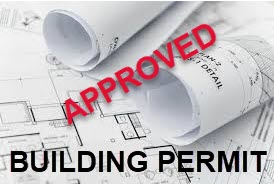 Depending on the complexity and type of your building project an owner/applicant can currently anticipate an average of 6-12 months to gather information, prepare and submit documentation, and obtain the building permit in the United States.
Depending on the complexity and type of your building project an owner/applicant can currently anticipate an average of 6-12 months to gather information, prepare and submit documentation, and obtain the building permit in the United States.
This blog focuses on streamlining the building permit procurement process after the required documentation has been completed. Depending your location, complexity and type of your project this construction permitting process may take a few weeks to several months or more.
The construction permitting process Building Permit Management System (BPMS) is based on the National Building Code (NBC) of the United States and its Rules and Regulations (RR). The process is broken down into two sequentially inter-related processes namely: (1) building permit and (2) certificate of occupancy. The provisions enumerated in the NBC and its RR serve as a guide for local governments in devising their own specific process flow in the issuance of building permits to all construction of residential, industrial and commercial buildings in their respective areas of jurisdiction.
Problem
Communities across the United States are not building enough homeless shelters and affordable housing to satisfy the demand. And long building permit waiting times add to this problem. A major issue causing long building permit times is the shortage of In-House employees to handle the increasing number of building permit and certificate of occupancy applications due to budget constraints and attracting qualified engineers and architects to apply.
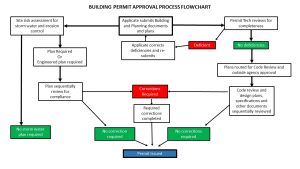
Solution – New Streamlined Process (NSP)
Under this new streamed process, the estimated processing time for building permits is two to seven days. A key feature of the NSP is the creation of an electronic back office (EBO) that simplifies the process for Owner/Applicants and Office of Building Officials (OBO). This NSP process allows for the simultaneous evaluation of the plans by the geodetic, architectural, structural, mechanical and plumbing engineers. Whereas, the current practice of reviewing these plans is sequentially by the OBO engineers and architects tasked to do the evaluation. Furthermore this process allows the Bureau of Fire Protection (BFP) to simultaneously review plans for Fire Safety Evaluation Clearance (FSEC) compliance. This streamlined process would employ independent contractors (licensed engineers and contractors) to augment the in-house personnel staff. This would greatly reduce the overall Office of Building Official (CBO) costs because these independent contractors are used on an as needed basis. And for the purpose of checks and balances, the outsourced group would perform document reviews while CBO personnel would perform evaluations.
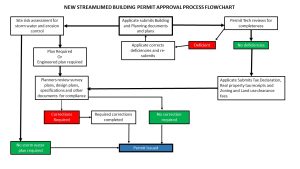
Getting a Building Permit
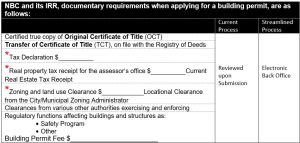
*The owner/ applicant will no longer need to secure because these clearances and documents because they will be secured “internally” by the Office of Building Official (OBO) and all fees and charges related to these documents and clearances will be added to the final building permit Fee.

Here is the sharable Service Provider App available on constructionplace.com for finding available Architects and Engineers to perform building permit reviewing services:
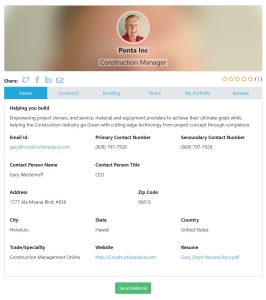

Master List of all projects requiring Building Permits – Create a master list of all units in the building by unit number. Constructionplace.com offers a virtual app that allows the Owner/Applicant to list all projects going through the. Building Permit Process with the ability to create a unique Project Directory for each project:
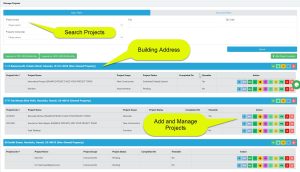
Recommendations
- Activate a One-Stop-Shop (OSS) with dedicated personnel for the following:
- Assessor’s Office (AO) for Tax Declaration and Real property tax receipts
- Zoning and Land Use Office (ZLUO) for clearance fees
This requires support of the respective Mayor’s Office to provide a budget for a fully functioning OSS. But this OSS would greatly reduce the legwork of the owner/applicant going from office to office reducing face-to-face interaction with OSS personnel thus increasing overall OSS productivity.
- Allow the Office of Fire Marshall (OFM) to waive the building permit approval:
The Fire Marshall’s office and the Office of Building Officials (OBO) should be able to evaluate the building permit application simultaneously because both are associated with fire and safety provisions. The Fire Marshall’s office would waive the building permit approval but would note their requirements and revisions on the building plans. Upon application for the Certificate of Occupancy COO, the Fire Marshall would inspect the building focusing on the noted requirements and revisions they previously noted on the plans thus further reduces the processing time for building permits.
- Automation of National Government Offices:
The Department of Environment and Natural Resources (DENR) and the Register of Deeds (RD) should consider automation for the clearances for the building permit and certificate of occupancy applications. Automation is the easiest and possibly the cheapest way to achieve this purpose.
- Allow the Applicant’s architects and engineers to certify the completeness and code compliance of their design plans, specifications and other documents for designated projects such as:
- Improvement projects with a designated project value
- Remodel projects with a designated project value.
- Other projects and values determined by the local jurisdiction.
Getting a Certificate of Occupancy







3 Comments
Wow that was odd. I just wrote an really long comment but after I clicked submit my
comment didn’t show up. Grrrr… well I’m not writing all that over again. Anyway, just wanted to say excellent
blog!
We are not sure what could have happened, maybe the internet broke at that particular moment because if there was an issue on our side we would not have received your comment which we appreciate. Glad you like this blog.
Hello.This article was extremely remarkable, especially since I was looking for thoughts on this subject last Saturday.